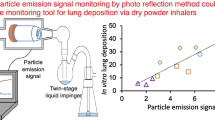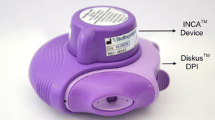Abstract
Purpose
Asthma is a prevalent lung disorder that cause heavy burdens globally. Inhalation medicaments can relieve symptoms, improve lung function and, thus, the quality of life. However, it is well-documented that patients often do not get the prescribed dose out of an inhaler and the deposition of drug is suboptimal, due to incorrect handling of the device and wrong inhalation technique. This study aims to design and fabricate an acoustic dry powder inhaler (ADPI) for monitoring inhalation flow and related drug administration in order to evaluate whether the patient receives the complete dose out of the inhaler.
Methods
The devices were fabricated using 3D printing and the impact of the acoustic element geometry and printing resolution on the acoustic signal was investigated. Commercial Foradil (formoterol fumarate) capsules were used to validate the availability of the ADPI for medication dose tracking. The acoustic signal was analysed with Partial-Least-Squares (PLS) regression.
Results
Indicate that specific acoustic signals could be generated at different air flow rates using a passive acoustic element with specific design features. This acoustic signal could be correlated with the PLS model to the air flow rate. A more distinct sound spectra could be acquired at higher printing resolution. The sound spectra from the ADPI with no capsule, a full capsule and an empty capsule are different which could be used for medication tracking.
Conclusions
This study shows that it is possible to evaluate the medication quality of inhaled medicaments by monitoring the acoustic signal generated during the inhalation process.









Similar content being viewed by others
References
Masoli M, Fabian D, Holt S, Beasley R, Program GI. f. a. the global burden of asthma: executive summary of the GINA dissemination committee report. Allergy. 2004;59(5):469–78.
Halbert R, Natoli J, Gano A, Badamgarav E, Buist AS, Mannino D. Global burden of COPD: systematic review and meta-analysis. Eur Respir J. 2006;28(3):523–32.
Celli BR, MacNee W, Agusti A, Anzueto A, Berg B, Buist AS, et al. Standards for the diagnosis and treatment of patients with COPD: a summary of the ATS/ERS position paper. Eur Respir J. 2004;23(6):932–46.
Man KNM, Tian Z, Lam DC-L, Wan JMF, Tan-Un KC. Satisfaction, preference and error occurrence of three dry powder inhalers as assessed by a cohort naïve to inhaler operation. International Journal of Chronic Obstructive Pulmonary Disease. 2018;13:1949.
Westerik JA, Carter V, Chrystyn H, Burden A, Thompson SL, Ryan D, et al. Characteristics of patients making serious inhaler errors with a dry powder inhaler and association with asthma-related events in a primary care setting. J Asthma. 2016;53(3):321–9.
Gradon L, Sosnowski TR. Formation of particles for dry powder inhalers. Adv Powder Technol. 2014;25(1):43–55.
Telko MJ, Hickey AJ. Dry powder inhaler formulation. Respir Care. 2005;50(9):1209–27.
Lavorini F, Magnan A, Dubus JC, Voshaar T, Corbetta L, Broeders M, et al. Effect of incorrect use of dry powder inhalers on management of patients with asthma and COPD. Respir Med. 2008;102(4):593–604.
Chew NY, Chan H-K. In vitro aerosol performance and dose uniformity between the Foradile® Aerolizer® and the Oxis® Turbuhaler®. Journal of Aerosol Medicine. 2001;14(4):495–501.
O’Connor BJ. The ideal inhaler: design and characteristics to improve outcomes. Respir Med. 2004;98:S10–6.
Wieshammer S, Dreyhaupt J. Dry powder inhalers: which factors determine the frequency of handling errors? Respiration. 2008;75(1):18–25.
Takaku Y, Kurashima K, Ohta C, Ishiguro T, Kagiyama N, Yanagisawa T, et al. How many instructions are required to correct inhalation errors in patients with asthma and chronic obstructive pulmonary disease? Respir Med. 2017;123:110–5.
Voshaar T, Spinola M, Linnane P, Campanini A, Lock D, Lafratta A, et al. Comparing usability of NEXThaler® with other inhaled corticosteroid/long-acting β2-agonist fixed combination dry powder inhalers in asthma patients. Journal of Aerosol Medicine and Pulmonary Drug Delivery. 2014;27(5):363–70.
Schuster, J. A.; Farr, S. J.; Hale, R., Vibration sensor based drug delivery monitor. Google Patents: 2016.
Plaza V, Fernández-Rodríguez C, Melero C, Cosío BG, Entrenas LM, de Llano LP, et al. Validation of the ‘test of the adherence to inhalers’(TAI) for asthma and COPD patients. Journal of Aerosol Medicine and Pulmonary Drug Delivery. 2016;29(2):142–52.
Klijn SL, Hiligsmann M, Evers SM, Roman-Rodriguez M, van der Molen T, van Boven JF. Effectiveness and success factors of educational inhaler technique interventions in asthma & COPD patients: a systematic review. NPJ primary care respiratory medicine. 2017;27(1):24.
Villa-Roel C, Nikel T, Ospina M, Voaklander B, Campbell S, Rowe BH. Effectiveness of educational interventions to increase primary care follow-up for adults seen in the emergency department for acute asthma: a systematic review and meta-analysis. Acad Emerg Med. 2016;23(1):5–13.
Florea C. Brief analysis of sounds using a smartphone. Phys Teach. 2019;57(4):214–5.
BBC Sound Effects. http://bbcsfx.acropolis.org.uk/
Coates MS, Chan H-K, Fletcher DF, Raper JA. Influence of air flow on the performance of a dry powder inhaler using computational and experimental analyses. Pharm Res. 2005;22(9):1445–53.
Buttini F, Brambilla G, Copelli D, Sisti V, Balducci AG, Bettini R, et al. Effect of flow rate on in vitro aerodynamic performance of NEXThaler® in comparison with Diskus® and Turbohaler® dry powder inhalers. Journal of Aerosol Medicine and Pulmonary Drug Delivery. 2016;29(2):167–78.
Goel, M.; Saba, E.; Stiber, M.; Whitmire, E.; Fromm, J.; Larson, E. C.; Borriello, G.; Patel, S. N. In Spirocall: Measuring lung function over a phone call, Proceedings of the 2016 CHI conference on human factors in computing systems, 2016; ACM: pp 5675–5685.
Steier J, Trammer T, Cloes R, Petro W. Optical feedback training of inhalation with autohaler® and Turbuhaler® in COPD patients. Lung. 2003;181(4):183–92.
Colthorpe P, Voshaar T, Kieckbusch T, Cuoghi E, Jauernig J. Delivery characteristics of a low-resistance dry-powder inhaler used to deliver the long-acting muscarinic antagonist glycopyrronium. Journal of drug assessment. 2013;2(1):11–6.
Lavorini F, Pistolesi M, Usmani OS. Recent advances in capsule-based dry powder inhaler technology. Multidisciplinary respiratory medicine. 2017;12(1):11.
Azouza W, Chrystyn H. Clarifying the dilemmas about inhalation techniques for dry powder inhalers: integrating science with clinical practice. Primary Care Respiratory Journal. 2012;21(2):208–13.
Pavkov R, Mueller S, Fiebich K, Singh D, Stowasser F, Pignatelli G, et al. Characteristics of a capsule based dry powder inhaler for the delivery of indacaterol. Curr Med Res Opin. 2010;26(11):2527–33.
Weuthen T, Roeder S, Brand P, Müllinger B, Scheuch G. In vitro testing of two formoterol dry powder inhalers at different flow rates. Journal of Aerosol Medicine. 2002;15(3):297–303.
De Boer A, Bolhuis G, Gjaltema D, Hagedoorn P. Inhalation characteristics and their effects on in vitro drug delivery from dry powder inhalers: part 3: the effect of flow increase rate (FIR) on the in vitro drug release from the Pulmicort 200 Turbuhaler. Int J Pharm. 1997;153(1):67–77.
Purves D, Fitzpatrick D, Katz LC, Lamantia AS, McNamara JO, Williams SM, et al. Neuroscience. 2nd ed. Sunderland: Sinauer Associates, Inc.; 2001.
Ji C, Zhao D, Han N, Li J. Parametric measurements of the effect of in-duct orifice edge shape on its noise damping performance. J Sound Vib. 2016;384:130–45.
Hoe S, Traini D, Chan H-K, Young PM. The influence of flow rate on the aerosol deposition profile and electrostatic charge of single and combination metered dose inhalers. Pharmaceutical Research. 2009;26(12):–2639.
Bagherisadeghi G, Larhrib EH, Chrystyn H. Real life dose emission characterization using COPD patient inhalation profiles when they inhaled using a fixed dose combination (FDC) of the medium strength Symbicort® Turbuhaler®. Int J Pharm. 2017;522(1–2):137–46.
Nahar K, Gupta N, Gauvin R, Absar S, Patel B, Gupta V, et al. In vitro, in vivo and ex vivo models for studying particle deposition and drug absorption of inhaled pharmaceuticals. Eur J Pharm Sci. 2013;49(5):805–18.
Funding
The Lundbeck Foundation (R218–2016-1323) and China Scholarship Council (201906240013) provided financial support for the conduct of the research. The funding sources were not involved in the study design; in the collection, analysis and interpretation of data; in the writing of the report; or in the decision to submit the article for publication.
Author information
Authors and Affiliations
Contributions
All authors have contributed to the conception and design of the study and acquisition, analysis and interpretation of data. All authors have drafted the article and revised it critically for important intellectual content. All authors have approved the final article. The authors certify that this manuscript, or any part of it, has not been published and will not be submitted elsewhere for publication while being considered by the Pharmaceutical Research journal.
Corresponding author
Ethics declarations
Conflict of Interest
The company Sonohaler has been formed in conjunction with the issuing of a patent on the acoustic element described in this article. Elsewise the authors disclose that no conflicting interests associated with the manuscript exist.
Additional information
Publisher’s Note
Springer Nature remains neutral with regard to jurisdictional claims in published maps and institutional affiliations.
Rights and permissions
About this article
Cite this article
Li, Y., Bohr, A., Jensen, H. et al. Medication Tracking: Design and Fabrication of a Dry Powder Inhaler with Integrated Acoustic Element by 3D Printing. Pharm Res 37, 38 (2020). https://doi.org/10.1007/s11095-020-2755-8
Received:
Accepted:
Published:
DOI: https://doi.org/10.1007/s11095-020-2755-8




